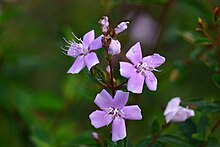Tibouchina aspera
| Tibouchina aspera | |
|---|---|

| |
| Scientific classification | |
| Kingdom: | Plantae |
| Clade: | Tracheophytes |
| Clade: | Angiosperms |
| Clade: | Eudicots |
| Clade: | Rosids |
| Order: | Myrtales |
| Family: | Melastomataceae |
| Genus: | Tibouchina |
| Species: | T. aspera
|
| Binomial name | |
| Tibouchina aspera Aubl.[2]
| |
| Synonyms[2] | |
| |
Tibouchina aspera is a species of flowering plant in the family Melastomataceae, native to Central America and tropical South America.[2] It was first described by Jean Fusée Aublet in 1775.[3] In the original description of the species, it was suggested that the plant was inhaled to treat chest pain and dry coughs.[4]
Description[edit]

Tibouchina aspera is a subshrub with densely scaly indumentum on the stem, petiole, calyces and hypanthium.[5][6]
Taxonomy[edit]
Tibouchina aspera was first described in 1775 and is the type species of the genus Tibouchina. The description was based on a specimen from French Guiana which is currently kept in the herbarium at the Natural History Museum in London.[7]
Varieties[edit]
There are three described varieties:[2]
- T. aspera var. aspera
- T. aspera var. asperrima Cogn.
- T. aspera var. poeppigii Cogn.
Distribution and habitat[edit]
Tibouchina aspera is widely distributed in Central and South America, including in Belize, Bolivia, Colombia, French Guiana, Guyana, Honduras, Nicaragua, Panama, Peru, Suriname, Venezuela, and in the Brazilian states of Amapá, Roraima, Amazonas, Pará, Acre, Rondônia, Maranháo, and Mato Grosso.[5] It is commonly found in the cerrado, campinas and restingas in humid, sandy soil. In a study of the Melastomataceae of the Brazilian restingas in Pará, T. aspera was found in herbaceous marsh, fields between dunes and open shrubby fields.[5]
References[edit]
- ^ Condit, R. (2019). "Tibouchina aspera". IUCN Red List of Threatened Species. 2019: e.T151946713A151946715. doi:10.2305/IUCN.UK.2019-3.RLTS.T151946713A151946715.en. Retrieved 2023-01-07.
- ^ a b c d "Tibouchina aspera Aubl.", Plants of the World Online, Royal Botanic Gardens, Kew, retrieved 2022-05-03
- ^ "Tibouchina aspera Aubl.", The International Plant Names Index, retrieved 2022-05-03
- ^ Aublet, Jean Baptiste Christophe Fusée (1775), Histoire des Plantes de la Guiane Françoise 1, Paris: Pierre-François Didot jeune, pp. 446–448
- ^ a b c de Lima, Laìce Fernanda Gomes; dos Santos, Joáo Ubiratan Moreira; do Rosário, Alessandro Silva; Baumgratz, José Fernando Andrade (2014), "Melastomataceae em formações costeiras de restingas no Pará, Brasil", Acta Amazonica, 44 (1): 45–58, doi:10.1590/s0044-59672014000100005
- ^ Lima, Jacqueline de Souza; Collevatti, Rosane Garcia; Soares, Thannya Nascimento; Chaves, Lázaro José; Telles, Mariana Pires de Campos (2015), "Fine-scale genetic structure in Tibouchina papyrus (Pohl) Toledo (Melastomataceae), an endemic and habitat-restricted species from Central Brazil", Plant Syst Evol, 301 (4): 1207–1213, doi:10.1007/s00606-014-1144-3
- ^ "Tibouchina aspera Aubl.", Tropicos, retrieved 2017-03-21

